Charging for usability
“Intuitive” or simply user-friendly interface has always been the “holy grail” of usability. Alas, the intuition is still a bit different for everyone, so the ideal remains unattainable. But this does not mean that you should not strive for it!
 Constantly improving the code, expanding the functionality of its products, do not forget about the interfaces. Therefore, we not only supported the first UI / UX ProfsoUX conference , which took place in St. Petersburg last Saturday, but also went there for new ideas and interesting acquaintances.
Constantly improving the code, expanding the functionality of its products, do not forget about the interfaces. Therefore, we not only supported the first UI / UX ProfsoUX conference , which took place in St. Petersburg last Saturday, but also went there for new ideas and interesting acquaintances.
Many participants were inspired by the task that our company offered to perform for everyone. We asked a simple question: “What should valves of cranes look like for creatures that do not have hands, but tentacles like octopuses?”. We agree, we are a little too cleverly clever and have not quite correctly formulated the question, but most of the “contestants” understood the task correctly and, by the end of the conference, there were already a hundred proposals on the design of these devices on our table.
Oh, it was a fascinating read! We want to present some of the suggested options to your attention and conduct a small ergonomic examination with the help of the collective mind of the masters.
')
We hope that the semi-humorous nature of this publication will not only fit the Friday mood, but also be able to generate an interesting discussion.
We admit honestly: we had no mercenary motives, and we are not even going to open the production of cranes for tentacle creatures. It was important for us to see how the forum participants relate to solving problems of taking into account user needs, in a seemingly simple, but not very unambiguous situation.
It's great that the participants demonstrated completely different approaches to solving the problem.
For example, philosophical, immediately questioning the conditions of the competition: “Why do I need taps? I'm an octopus! ”Probably, a person with a healthy share of pragmatism and skepticism will never do extra work and save time for himself and his employer.
Or engineering and applied: Acting on the principle “everything is already invented before us”, they tried to use existing devices for the needs of unusual users:
Fig. one:
Fig. 2: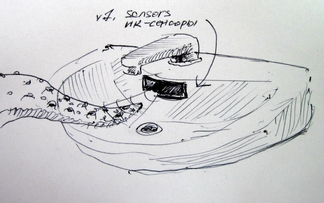
Fig. 3:
Fig. four: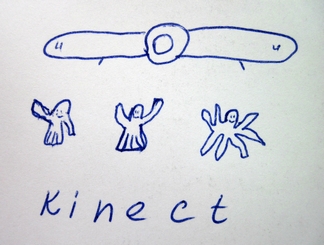
Indeed, why reinvent the "bicycle" if you can successfully apply it to the task? Even the most demanding tentacles are likely to satisfy the achievements of human technological thought.
Someone showed his artistic abilities, depicting in detail not only the device itself, but also its potential user:
Fig. five: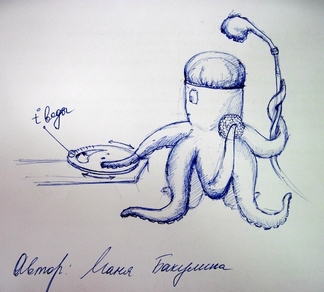
Fig. 6:
As a rule, such figures were not accompanied by explanations at all.
This is where the "affordans" should work. Works?
Many contestants showed outstanding analytical skills by writing more than one page with a detailed analysis of the anatomy and tentacles principle:
Fig. 7: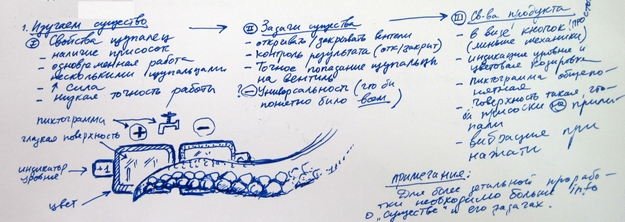
A detailed analysis before the assignment demonstrates a brilliant and very ergonomic-based approach to solving the problem.
Fig. eight:
Taking into account additional factors, such as the slippery tentacles, will make the taps more comfortable for the tentacles so that the creatures are not so worried about the lack of fingers.
Fig. 9: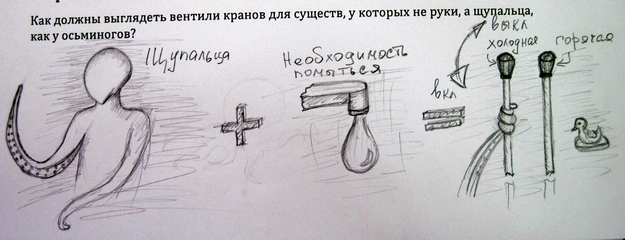
Initially, the question was formulated in such a way that it did not directly follow from it that a creature with tentacles “like an octopus” is an octopus. Separately pleased the participants who caught this detail, and specified who they mean when solving the problem. Body type is important, as it depends on the way the attachment of effort.
A variety of levers, knife switches and sliders were generally popular. Octopuses (or humanoids with tentacles) can undoubtedly pull on themselves, but can they push something from themselves?
They don’t have any bones, but our ergonomics expert found it hard enough to answer the muscles, and took time to consult at the Oceanarium (unfortunately, there are no humanoids with tentacles available). Our specialist went there a few hours ago, and we already started to worry about him.
Fig. ten: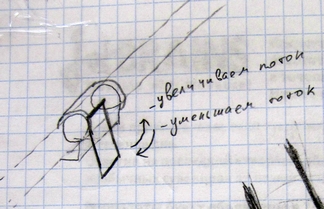
Fig. eleven:
But the author of the next project has forgotten that the tentacles also come in different thicknesses.
Fig. 12:

However, like shoes, taps can be produced in different sizes ...
We received a lot of projects whose authors tried to think outside the box:
Fig. 13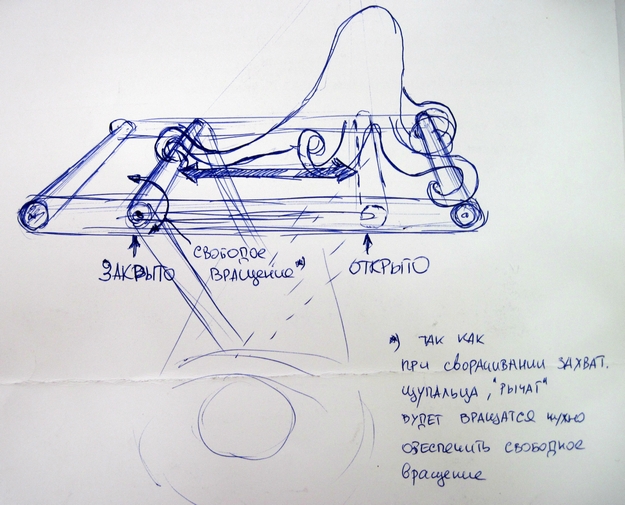
Interesting mix of crane and simulator. An advertising campaign for such devices "Train Tentacles!" Would be held at "Hurray!"
Fig. 14: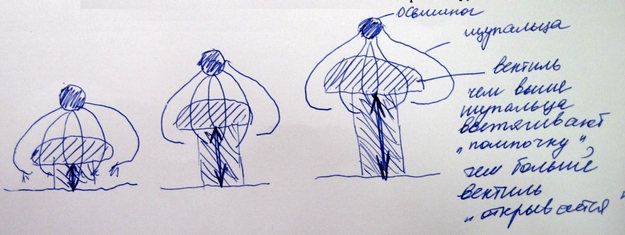
It clearly shows the industrial scale crane construction. A crane the size of a creature, and requiring the whole body to regulate, must open at least a valve on the oil pipe.
And the next solution is very unusual, but, unfortunately, it is still not technologically feasible.
Fig. 15:
But on the basis of it, we had a brilliant idea: you can use octopuses on a sausage factory.
Fig. sixteen:
Perhaps the most original and unlikely solution. If the assumption is true, then such a construction will indeed be one of the most convenient for the tentacles.
And finally, pure futurism:
Fig. 17:
Brain they have! They are generally one of the most developed invertebrates. As soon as science can fully make systems that respond to brain impulses for a person, it will immediately go to octopuses.
Alas, the publication format does not allow to put all the creatives that ProfsoUX members generously shared with us.
We marked our favorites with prizes after the conference. They not only painted the device itself, but were able to substantiate in detail the choice of certain decisions.
And which of the works would you select? What was the best solution and why?
Or maybe you want to offer your own version?
 Constantly improving the code, expanding the functionality of its products, do not forget about the interfaces. Therefore, we not only supported the first UI / UX ProfsoUX conference , which took place in St. Petersburg last Saturday, but also went there for new ideas and interesting acquaintances.
Constantly improving the code, expanding the functionality of its products, do not forget about the interfaces. Therefore, we not only supported the first UI / UX ProfsoUX conference , which took place in St. Petersburg last Saturday, but also went there for new ideas and interesting acquaintances.Many participants were inspired by the task that our company offered to perform for everyone. We asked a simple question: “What should valves of cranes look like for creatures that do not have hands, but tentacles like octopuses?”. We agree, we are a little too cleverly clever and have not quite correctly formulated the question, but most of the “contestants” understood the task correctly and, by the end of the conference, there were already a hundred proposals on the design of these devices on our table.
Oh, it was a fascinating read! We want to present some of the suggested options to your attention and conduct a small ergonomic examination with the help of the collective mind of the masters.
')
We hope that the semi-humorous nature of this publication will not only fit the Friday mood, but also be able to generate an interesting discussion.
We admit honestly: we had no mercenary motives, and we are not even going to open the production of cranes for tentacle creatures. It was important for us to see how the forum participants relate to solving problems of taking into account user needs, in a seemingly simple, but not very unambiguous situation.
It's great that the participants demonstrated completely different approaches to solving the problem.
For example, philosophical, immediately questioning the conditions of the competition: “Why do I need taps? I'm an octopus! ”Probably, a person with a healthy share of pragmatism and skepticism will never do extra work and save time for himself and his employer.
Or engineering and applied: Acting on the principle “everything is already invented before us”, they tried to use existing devices for the needs of unusual users:
Fig. one:

Fig. 2:

Fig. 3:

Fig. four:

Indeed, why reinvent the "bicycle" if you can successfully apply it to the task? Even the most demanding tentacles are likely to satisfy the achievements of human technological thought.
Someone showed his artistic abilities, depicting in detail not only the device itself, but also its potential user:
Fig. five:

Fig. 6:

As a rule, such figures were not accompanied by explanations at all.
This is where the "affordans" should work. Works?
Many contestants showed outstanding analytical skills by writing more than one page with a detailed analysis of the anatomy and tentacles principle:
Fig. 7:

A detailed analysis before the assignment demonstrates a brilliant and very ergonomic-based approach to solving the problem.
Fig. eight:

Taking into account additional factors, such as the slippery tentacles, will make the taps more comfortable for the tentacles so that the creatures are not so worried about the lack of fingers.
Fig. 9:

Initially, the question was formulated in such a way that it did not directly follow from it that a creature with tentacles “like an octopus” is an octopus. Separately pleased the participants who caught this detail, and specified who they mean when solving the problem. Body type is important, as it depends on the way the attachment of effort.
A variety of levers, knife switches and sliders were generally popular. Octopuses (or humanoids with tentacles) can undoubtedly pull on themselves, but can they push something from themselves?
They don’t have any bones, but our ergonomics expert found it hard enough to answer the muscles, and took time to consult at the Oceanarium (unfortunately, there are no humanoids with tentacles available). Our specialist went there a few hours ago, and we already started to worry about him.
Fig. ten:

Fig. eleven:

But the author of the next project has forgotten that the tentacles also come in different thicknesses.
Fig. 12:


However, like shoes, taps can be produced in different sizes ...
We received a lot of projects whose authors tried to think outside the box:
Fig. 13

Interesting mix of crane and simulator. An advertising campaign for such devices "Train Tentacles!" Would be held at "Hurray!"
Fig. 14:

It clearly shows the industrial scale crane construction. A crane the size of a creature, and requiring the whole body to regulate, must open at least a valve on the oil pipe.
And the next solution is very unusual, but, unfortunately, it is still not technologically feasible.
Fig. 15:

But on the basis of it, we had a brilliant idea: you can use octopuses on a sausage factory.
Fig. sixteen:

Perhaps the most original and unlikely solution. If the assumption is true, then such a construction will indeed be one of the most convenient for the tentacles.
And finally, pure futurism:
Fig. 17:

Brain they have! They are generally one of the most developed invertebrates. As soon as science can fully make systems that respond to brain impulses for a person, it will immediately go to octopuses.
Alas, the publication format does not allow to put all the creatives that ProfsoUX members generously shared with us.
We marked our favorites with prizes after the conference. They not only painted the device itself, but were able to substantiate in detail the choice of certain decisions.
And which of the works would you select? What was the best solution and why?
Or maybe you want to offer your own version?
Source: https://habr.com/ru/post/144525/
All Articles